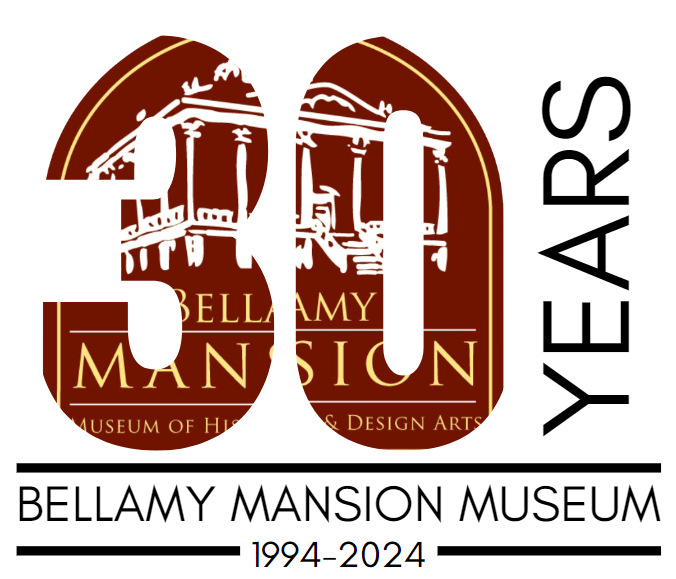1. Orientation and Carriage House
Orientation
The Bellamy mansion is one of North Carolina’s premier architectural and historic treasures and remains a spectacular example of blended architectural styles--Classical Revival and Italianate.
In 1859, Dr. John D. Bellamy--successful physician, planter, and merchant—hired local architect James F. Post and Connecticut draftsman Rufus Bunnell to design his new townhome. The two architects oversaw enslaved workers, free black artisans, and white mechanics who built the mansion and outbuildings between late 1859 and early 1861. Though the Bellamy family had a plantation right across the Cape Fear River with a handsome home, the 22-room 10,000-square-feet house at 5th and Market Streets became the main residence of Dr. Bellamy, his wife Eliza Harriss Bellamy, and their nine children.
Ten Bellamys and up to ten enslaved workers moved in at 503 Market St. on the eve of the American Civil War only to be displaced little more than a year later first by a yellow fever epidemic that ravaged Wilmington in 1862 and later by the war itself. The only person left “in charge of the premises” from 1862-1865 was the Bellamys enslaved cook, Sarah.
When Wilmington fell to Federal troops in 1865, the Union army used the empty Bellamy mansion as their Wilmington headquarters. Brigadier General of the Union Army, Joseph Hawley, also resided in the home from March 1865 to approximately June 1865, and the Bellamys only regained their home after Dr. Bellamy traveled to Washington D.C. and obtained a presidential pardon from President Andrew Johnson. The Bellamys moved back in the fall of 1865.
Dr. Bellamy was a prominent and influential Wilmingtonian, and his nine children went on to success in politics, business, medicine, and law. The mansion remained the family residence until 1946 when the last of John and Eliza’s children, Ellen D. Bellamy, died in the house at age 93. Dozens of heirs had claim to the residence, but eventually two owned it outright, though no one ever moved into the home.
In 1972, descendants formed the non-profit, Bellamy Mansion Inc., to restore the mansion and open it as a museum. A few short weeks later, an arsonist(s) attempted to burn the mansion down and a devastating fire ripped through the home. No one was caught or convicted for the fire, but the hopes of restoration were put on hold until 1989 when the family donated the home to Preservation North Carolina. Interior restoration began in 1992 and the Bellamy Mansion Museum opened to the public in the spring of 1994. The restoration of the original slave quarters was over a decade in the making. It was opened to the public in 2014, completely restored to its original 1859 look.
The Bellamy mansion is one of North Carolina’s premier architectural and historic treasures and remains a spectacular example of blended architectural styles--Classical Revival and Italianate.
In 1859, Dr. John D. Bellamy--successful physician, planter, and merchant—hired local architect James F. Post and Connecticut draftsman Rufus Bunnell to design his new townhome. The two architects oversaw enslaved workers, free black artisans, and white mechanics who built the mansion and outbuildings between late 1859 and early 1861. Though the Bellamy family had a plantation right across the Cape Fear River with a handsome home, the 22-room 10,000-square-feet house at 5th and Market Streets became the main residence of Dr. Bellamy, his wife Eliza Harriss Bellamy, and their nine children.
Ten Bellamys and up to ten enslaved workers moved in at 503 Market St. on the eve of the American Civil War only to be displaced little more than a year later first by a yellow fever epidemic that ravaged Wilmington in 1862 and later by the war itself. The only person left “in charge of the premises” from 1862-1865 was the Bellamys enslaved cook, Sarah.
When Wilmington fell to Federal troops in 1865, the Union army used the empty Bellamy mansion as their Wilmington headquarters. Brigadier General of the Union Army, Joseph Hawley, also resided in the home from March 1865 to approximately June 1865, and the Bellamys only regained their home after Dr. Bellamy traveled to Washington D.C. and obtained a presidential pardon from President Andrew Johnson. The Bellamys moved back in the fall of 1865.
Dr. Bellamy was a prominent and influential Wilmingtonian, and his nine children went on to success in politics, business, medicine, and law. The mansion remained the family residence until 1946 when the last of John and Eliza’s children, Ellen D. Bellamy, died in the house at age 93. Dozens of heirs had claim to the residence, but eventually two owned it outright, though no one ever moved into the home.
In 1972, descendants formed the non-profit, Bellamy Mansion Inc., to restore the mansion and open it as a museum. A few short weeks later, an arsonist(s) attempted to burn the mansion down and a devastating fire ripped through the home. No one was caught or convicted for the fire, but the hopes of restoration were put on hold until 1989 when the family donated the home to Preservation North Carolina. Interior restoration began in 1992 and the Bellamy Mansion Museum opened to the public in the spring of 1994. The restoration of the original slave quarters was over a decade in the making. It was opened to the public in 2014, completely restored to its original 1859 look.
Carriage House
The carriage house housed the Bellamys’ horses, carriages, and family cow. The second floor, or hay loft area, was likely the sleeping quarters of Guy Nixon, the enslaved butler and coachman, and Tony Bellamy, an enslaved caretaker, who maintained the mansion and the grounds. The original carriage house was condemned and destroyed in 1946, following the death of the last family member to live on site. It was reconstructed in 2001 to serve as a visitor center, gift shop, and museum office space.
The carriage house housed the Bellamys’ horses, carriages, and family cow. The second floor, or hay loft area, was likely the sleeping quarters of Guy Nixon, the enslaved butler and coachman, and Tony Bellamy, an enslaved caretaker, who maintained the mansion and the grounds. The original carriage house was condemned and destroyed in 1946, following the death of the last family member to live on site. It was reconstructed in 2001 to serve as a visitor center, gift shop, and museum office space.




